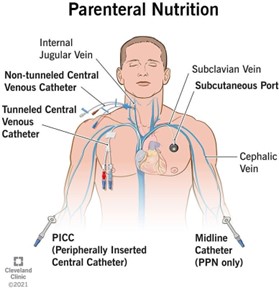Which intervention is most important for the practical nurse (PN) to implement for a client who is receiving total parenteral nutrition (TPN)?
Collect fingerstick glucose levels
Implement bleeding precautions
Obtain daily weights
Check urine for albumin
The Correct Answer is A
a) Collect fingerstick glucose levels. Correct
Collecting fingerstick glucose levels is the most important intervention for the PN to implement for a client who is receiving TPN. TPN is a method of feeding that bypasses the gastrointestinal tract and provides all the nutritional needs of the body through a vein. TPN contains a high concentration of glucose, which can cause hyperglycemia or fluctuations in blood sugar levels. Therefore, it is essential to monitor the client's glucose levels frequently and adjust the infusion rate or insulin administration accordingly.
b) Implement bleeding precautions.
Implementing bleeding precautions is not the most important intervention for the PN to implement for a client who is receiving TPN. Bleeding precautions are measures to prevent or minimize bleeding in clients who have a high risk of hemorrhage due to conditions such as thrombocytopenia, coagulopathy, or anticoagulant therapy. TPN does not directly increase the risk of bleeding, although it may affect the liver function and clotting factors in some cases². Therefore, bleeding precautions are not a priority for a client who is receiving TPN.
c) Obtain daily weights.
Obtaining daily weights is not the most important intervention for the PN to implement for a client who is receiving TPN. Obtaining daily weights is a way to monitor the client's fluid balance, nutritional status, and response to therapy. TPN can cause fluid overload, dehydration, or electrolyte imbalances in some cases²⁵. Therefore, obtaining daily weights is important, but not as important as monitoring glucose levels.
d) Check urine for albumin.
Checking urine for albumin is not the most important intervention for the PN to implement for a client who is receiving TPN. Checking urine for albumin is a way to detect proteinuria, which is an indicator of kidney damage or disease. TPN does not directly cause kidney problems, although it may affect the renal function and urine output in some cases². Therefore, checking urine for albumin is not a priority for a client who is receiving TPN.
 |
Nursing Test Bank
Naxlex Comprehensive Predictor Exams
Related Questions
Correct Answer is A
Explanation
Seizure precauons are measures taken to protect a client who is at risk of having a seizure, which is a sudden and abnormal electrical acvity in the brain that can cause changes in behavior, movement, sensaon, or consciousness. Seizure precauons include providing a safe environment, monitoring the client's vital signs and neurological status, administering anconvulsant medicaons, and documenng the onset, duraon, and characteriscs of any seizure acvity³.
One of the potenal complicaons of a seizure is aspiraon, which is the inhalaon of foreign material into the lungs, such as saliva, vomit, or food. Aspiraon can cause choking, pneumonia, or respiratory distress. To prevent or treat aspiraon, the praccal nurse (PN) should ensure the ready availability of equipment to perform suconing of the trachea, which is the tube that connects the mouth and nose to the lungs. Suconing of the trachea involves inserng a catheter through the nose or mouth into the trachea and applying negave pressure to remove any secreons or debris from the airway.
Therefore, opon A is the correct answer, while opons B, C, and D are incorrect.
Opon B is incorrect because inserng a urinary catheter is not related to seizure precauons or aspiraon prevenon.
Opon C is incorrect because applying so restraints may not be necessary or appropriate for a client who requires seizure precauons, as they may interfere with the natural movements of the seizure or cause injury to the client.
Opon D is incorrect because inserng a nasogastric tube is not related to seizure precauons or aspiraon prevenon.
Correct Answer is B
Explanation
Choice A reason: Encouraging community members to practice fire drills is an activity that is a part of the prevention/mitigation phase of the disaster management cycle because it can reduce the risk of injury or death from fire by increasing the awareness and preparedness of the community.
Choice B reason: Identifying community members who have disabilities is an activity that is a part of the prevention/mitigation phase of the disaster management cycle because it can reduce the vulnerability of these individuals by ensuring that they have access to appropriate resources and assistance in case of a disaster.
Choice C reason: Providing first aid to community members affected by a tornado is not an activity that is a part of the prevention/mitigation phase of the disaster management cycle, but rather the response phase, which involves delivering immediate and short-term assistance to save lives and meet basic needs during and after a disaster.
Choice D reason: Assisting community members in developing a disaster plan is not an activity that is a part of the prevention/mitigation phase of the disaster management cycle, but rather the preparedness phase, which involves enhancing the readiness and capabilities of individuals, organizations, and communities to respond to and recover from a disaster.
Whether you are a student looking to ace your exams or a practicing nurse seeking to enhance your expertise , our nursing education contents will empower you with the confidence and competence to make a difference in the lives of patients and become a respected leader in the healthcare field.
Visit Naxlex, invest in your future and unlock endless possibilities with our unparalleled nursing education contents today
Report Wrong Answer on the Current Question
Do you disagree with the answer? If yes, what is your expected answer? Explain.
Kindly be descriptive with the issue you are facing.
